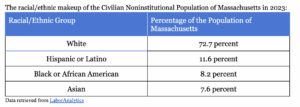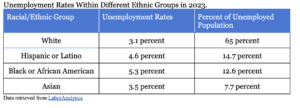Unemployment in Massachusetts by Race
According to the 2020 census, Massachusetts had a population of 7,029,917 people, making it the 15th largest state by population. But in terms of geographical size, it is the seventh smallest. The densely populated Bay State, containing the major economic hub of Boston, continues to be an attractive destination for immigrants.
In fact, Massachusetts is one of the most diverse states in New England. According to the Census Bureau’s Diversity Index, Massachusetts trails only Connecticut in its diversity rating. The Diversity Index is a measure determining the likelihood of choosing from a random population group, and selecting individuals from different racial or ethnic backgrounds. It ranges from 0 to 100 percent, 0 being completely racially homogenous, and 100 being everyone belonging to a distinct ethnic group. The 2020 census determined that the DI of the United States was 61.1 percent. Massachusetts fell below this national average with a DI of 51.6 percent, ranking 26th out of the 50 states plus Washington D.C. However, it is important to recognize that the Bay State has diversified significantly since 2010, increasing its index by over 10 percentage points.

The population of Massachusetts in 2023 was majority white (72.7 percent), followed by Hispanic and Latino (11.6 percent), black and African Americans (8.2 percent), and the smallest percentage being Asian (7.6 percent). Now that there is an understanding of the racial composition of Massachusetts, let’s look at how unemployment has different effects on these groups.
According to Pioneer Institute’s LaborAnalytics, the unemployment rate in Massachusetts in 2023 for white individuals in the labor force, who make up 65 percent of all unemployed individuals, was 3.1 percent. For black or African Americans, the unemployment rate was 5.3 percent, and those individuals accounted for 12.6 percent of the unemployed population. For Hispanics or Latinos the UE rate was 4.6 percent, making up 14.7 percent of the unemployed population. Lastly, for Asians it was 3.5 percent and 7.7 percent of the total unemployed population. This demonstrates that minority populations are disproportionately more likely to be unemployed compared to their white counterparts in Massachusetts.

The difference may partially be explained by historical disadvantages for minorities in the labor force. Racial and ethnic minority groups, specifically blacks and African Americans and Hispanics and Latinos in Massachusetts face larger obstacles in terms of employment opportunities. These groups face higher unemployment rates than whites, and comprise a larger portion of the unemployed population in comparison to their composition of the entire civilian labor force of Massachusetts. The state has, and continues to, implement strategies to close the racial/ethnic unemployment gap, but it is clear that more needs to be done to completely solve this pressing issue.
Dana DiChiro is a Roger Perry Government Transparency Intern at the Pioneer Institute for Summer 2024. She is a rising senior studying Government & Politics and Economics at the University of Maryland, College Park.



